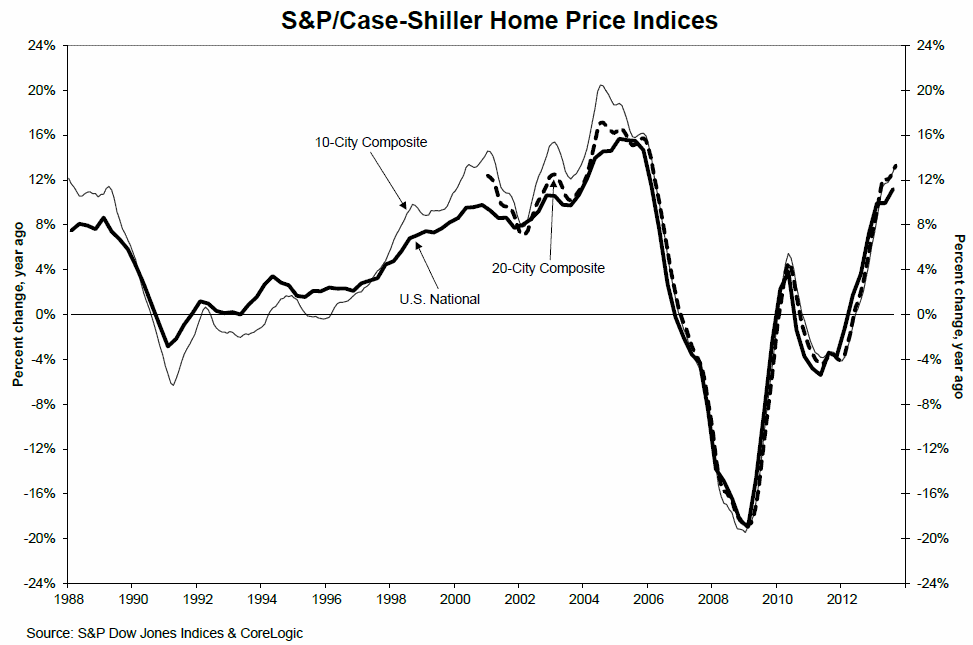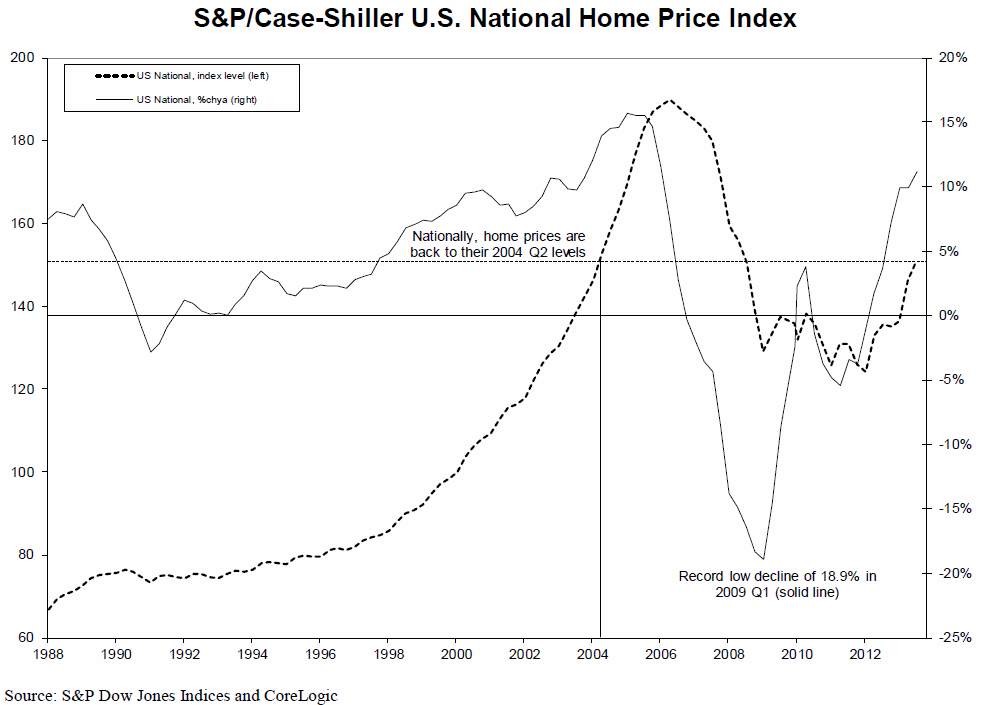Home prices continue to increase nationally, and the S&P Case-Shiller's U.S. National Home Price Index which is issued quarterly showed a strong third quarter where prices increased by 3.2 percent. This bring price gains over the last four quarters to 11.2 percent.
The Case-Shiller monthly indices for September, however, once again show that the rate of price increases is slackening. The 10-City and 20-City Composite Indices each gained 0.7 percent from August to September compared to 1.3 percent gains from July to August. The two measures each posted 13.3 percent increases year-over-year. While 13 of the 20 cities tracked by the indices had higher annual growth rates, 19 had smaller increases in September than in August.

"The second and third quarters of 2013 were very good for home prices," says David M. Blitzer, Chairman of the Index Committee at S&P Dow Jones Indices. "The National Index is up 11.2% year- over-year, the strongest figure since the boom peaked in 2006. The 10-City and 20-City Composites year-over-year growth at 13.3% was their highest annual numbers since February 2006.
"Housing continues to emerge from the financial crisis: the proportion of homes in foreclosure is declining and consumers' balance sheets are strengthening. The longer run question is whether household formation continues to recover and if home ownership will return to the peak levels seen in 2004."
As of the third quarter of 2013, average home prices across the United States are back to their levels posted in the second quarter of 2004. Measured from their June/July 2006 peaks, the peak-to-current decline for both Composites is approximately 20%. The recovery from the March 2012 lows is 22.9% and 23.6% for the 10-City and 20-City Composites. At the end of the third quarter of 2013, the National Index was up 3.2% over the second quarter of 2013 and 11.2% above the third quarter of 2012.

Blitzer pointed to especially strong showings in the Western part of the country. Las Vegas had an annual price increase of 29.1 percent followed by San Francisco at 25.7 percent, Los Angeles at 21.8 percent and San Diego at 20.9 percent. These were the highest annual rates for San Francisco and Los Angeles since March 2001 and December 2005 respectively
Blitzer said the strong performance in the West is sparking questions and concerns about the possibility of another bubble. "However the talk is focused on fear of a bubble, not a rush to join the party and buy. Moreover, other data suggest a market beginning to shift to slower growth rather than one about to accelerate. Existing home sales weakened in the most recent report, home construction remains far below the boom levels of six or seven years ago and interest rates are expected to be higher a year from now."
Other cities with double digit year-over-year increases were Atlanta and Phoenix at 18.7 and 18.6 percent respectively; Detroit (17.2 percent), Tampa (14.5 percent) Miami (14.3 percent), Seattle (13.2 percent), and Minneapolis (10.1 percent). Chicago, while not in double digits, also made a strong showing with its highest year-over-year gain since November 2005, 9.7 percent.
Among the 19 cities where the growth rate dropped from August to September Las Vegas which went from +2.9 percent in August to +1.3 percent in September and Tampa, dropping from +1.8 percent to +0.2 percent. Charlotte was the only city to post a negative monthly return for September, its first since November 2012.
Thirteen cities improved their year-over-year returns from those in August. Cleveland accelerated the most (from +3.7 percent in August to +5.0 percent in September), but it remains the second worst performing city with only New York trailing at +4.3 percent.
The S&P/Case-Shiller Home Price Indices constructed to accurately track the price path of typical single-family homes located in each metropolitan area provided. Each index combines matched price pairs for thousands of individual houses from the available universe of arms-length sales data. The indices have a base value of 100 in January 2000; thus, for example, a current index value of 150 translates to a 50% appreciation rate since January 2000 for a typical home located within the subject market.







